Converting Climate Change Gridded Daily Rainfall to Station Daily Rainfall—A Case Study at Zengwen Reservoir
Abstract
1. Introduction
2. Materials and Methods
2.1. Future Scenario and GCM Data
2.2. GCMs Ranking and Selection
2.3. Study Area and Observation Data
2.4. Hydrological Model
3. Two-Stage Bias Correction Method
3.1. Quantile Mapping Bias Correction Method
3.2. Wet-Day Threshold Optimization
4. Analysis and Discussion
4.1. Analysis with Different Wet-Day Thresholds
4.1.1. Comparison to Averaged Daily Rainfall
4.1.2. Comparison to Probability of Precipitation
4.1.3. Comparison to Annual Average Runoff of the Watershed
4.2. Discussion
5. Conclusions
Author Contributions
Funding
Institutional Review Board Statement
Informed Consent Statement
Data Availability Statement
Acknowledgments
Conflicts of Interest
References
- Water Resources Agency. Strengthening Water Supply System Adaptive Capacity to Climate Change in Southern Region; Water Resources Agency: Taipei, Taiwan, 2011. (In Chinese) [Google Scholar]
- Jones, P.; Harpham, C.; Kilsby, C.; Glenis, V.; Burton, A. UK Climate Projections Science Report: Projections of Future Daily Climate for the UK from the Weather Generator, Project Report; UK Climate Projections; Met Office: Exeter, UK, 2010. [Google Scholar]
- Tung, Y.S.; Chen, C.T.; Liu, J.J.; Chen, Y.M. Daily Statistics Downscaling for CMIP5 AGCM: Validation and Application; NCDR 107-T19; National Science and Technology Center for Disaster Reduction: New Taipei Cty, Taiwan, 2018. (In Chinese) [Google Scholar]
- Liu, H.W.; Lin, S.L.; Chen, C.T.; Tung, Y.S.; Chen, Y.M. Key Indicators of Climate Change in Taiwan; National Science and Technology Center for Disaster Reduction: New Taipei city, Taiwan, 2019. (In Chinese) [Google Scholar]
- Li, Y.C.; Wang, C.C.; Weng, S.P.; Chen, C.T. Future Projections of Meteorological Drought Characteristics in Taiwan. Atmos. Sci. 2019, 47, 66–91. [Google Scholar]
- Huang, Y.W.; Liu, H.W. Assessment of the impact of rainfall on grapes under climate change-Taking Changhua County as an example. Newsl. Taiwan Clim. Chang. Proj. Inf. Adapt. Knowl. Platf. 2019, 32. Available online: https://tccip.ncdr.nat.gov.tw/km_newsletter_one.aspx?nid=20191005114602 (accessed on 25 May 2021). (In Chinese).
- Tung, Y.S.; Liu, T.M.; Chang, C.W.; Sun, S.; Lin, S.Y.; Huang, Y.C.; Lee, H.L. Questions and Answers on Statistical Downscaling Daily Data; National Science and Technology Center for Disaster Reduction: New Taipei City, Taiwan, 2019. (In Chinese) [Google Scholar]
- Ines, A.V.M.; Hansen, J.W. Bias correction of daily GCM rainfall for crop simulation studies. Agric. For. Meteorol. 2006, 138, 44–53. [Google Scholar] [CrossRef]
- Johnson, F.; Sharma, A. Accounting for interannual variability: A comparison of options for water resources climate change impact assessments. Water Resour. Res. 2011, 47, W04508. [Google Scholar] [CrossRef]
- Su, Y.F.; Cheng, C.T.; Liou, J.J.; Chen, Y.M.; Kitoh, A. Bias correction of MRI-WRF dynamic downscaling datasets. Terr. Atmos. Ocean. Sci. 2016, 27, 649–657. [Google Scholar] [CrossRef]
- Intergovernmental Panel on Climate Change (IPCC). Summary for Policymakers. In Climate Change 2013: The Physical Science Basis. Contribution of Working Group I to the Fifth Assessment Report of the Intergovernmental Panel on Climate Change; Cambridge University Press: Cambridge, UK; New York, NY, USA, 2013. [Google Scholar]
- Tung, Y.S.; Wang, S.Y.; Chu, J.L.; Wu, C.H.; Chen, Y.M.; Cheng, C.T.; Lin, L.Y. Projected increase of the East Asian summer monsoon (Meiyu) in Taiwan by climate models with variable performance. Meteorol. Appl. 2020, 27, e1886. [Google Scholar] [CrossRef]
- Reichler, T.; Kim, J. How well do coupled models simulate today’s climate? Bull. Am. Meteor. Soc. 2008, 89, 303–311. [Google Scholar] [CrossRef]
- Wang, B.; Lin, H. Rainy Season of the Asian–Pacific Summer Monsoon. J. Clim. 2002, 15, 386–398. [Google Scholar] [CrossRef]
- Haith, D.A.; Mandel, R.; Wu, R.S. GWLF, Generalized Watershed Loading Functions, Version 2.0, User’s Manual; Department of Agricultural & Biological Engineering, Cornell University: Ithaca, NY, USA, 1992. [Google Scholar]
- Karl, T.R.; Nicholls, N.; Ghazi, A. CLIVAR/GCOS/WMO workshop on indices and indicators for climate extremes: Workshop summary. Clim. Chang. 1999, 42, 3–7. [Google Scholar] [CrossRef]
- Peterson, T.C.; Folland, C.; Gruza, G.; Hogg, W.; Mokssit, A.; Plummer, N. Report on the Activities of the Working Group on Climate Change Detection and Related Rapporteurs 1998–2001; WMO/TD-No. 1071; WCDMP-No. 47; World Meteorological Organization: Geneva, Switzerland, 2001. [Google Scholar]
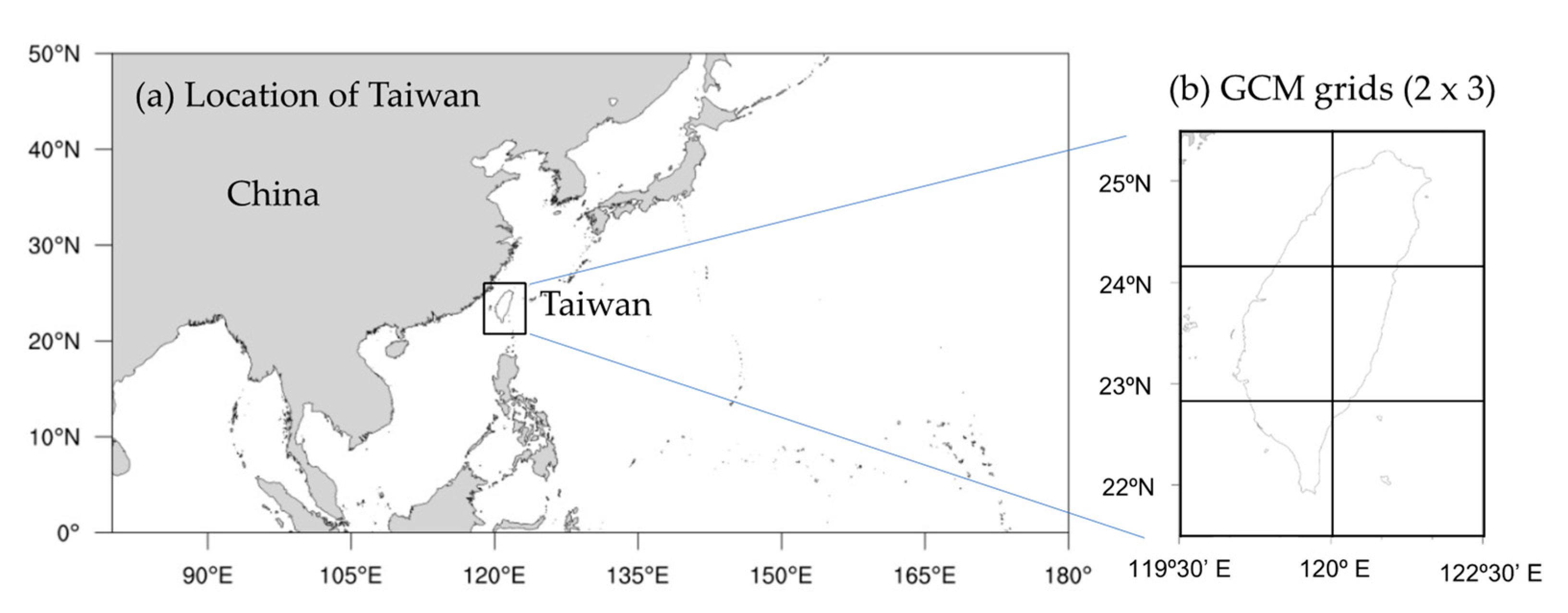
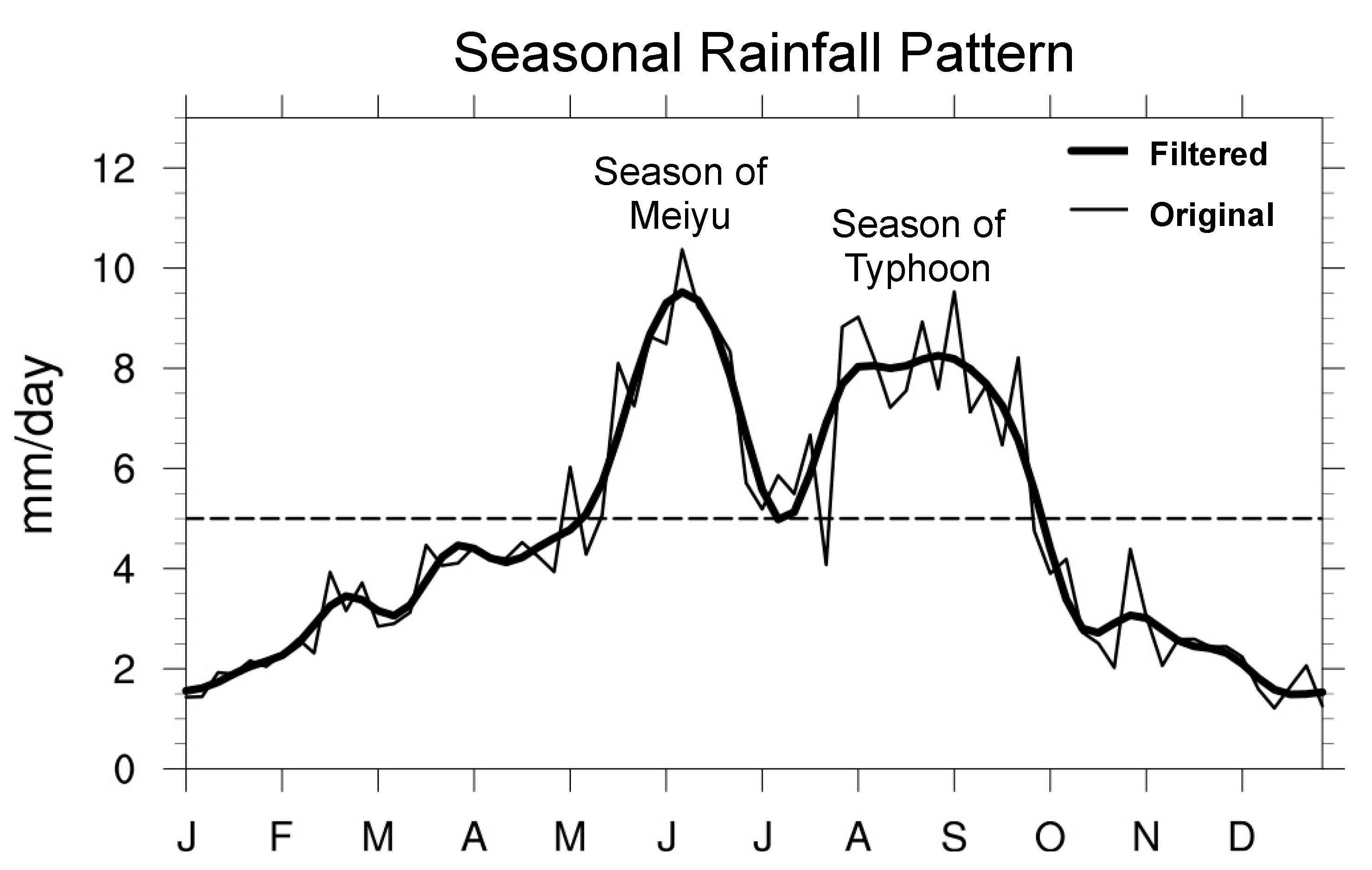
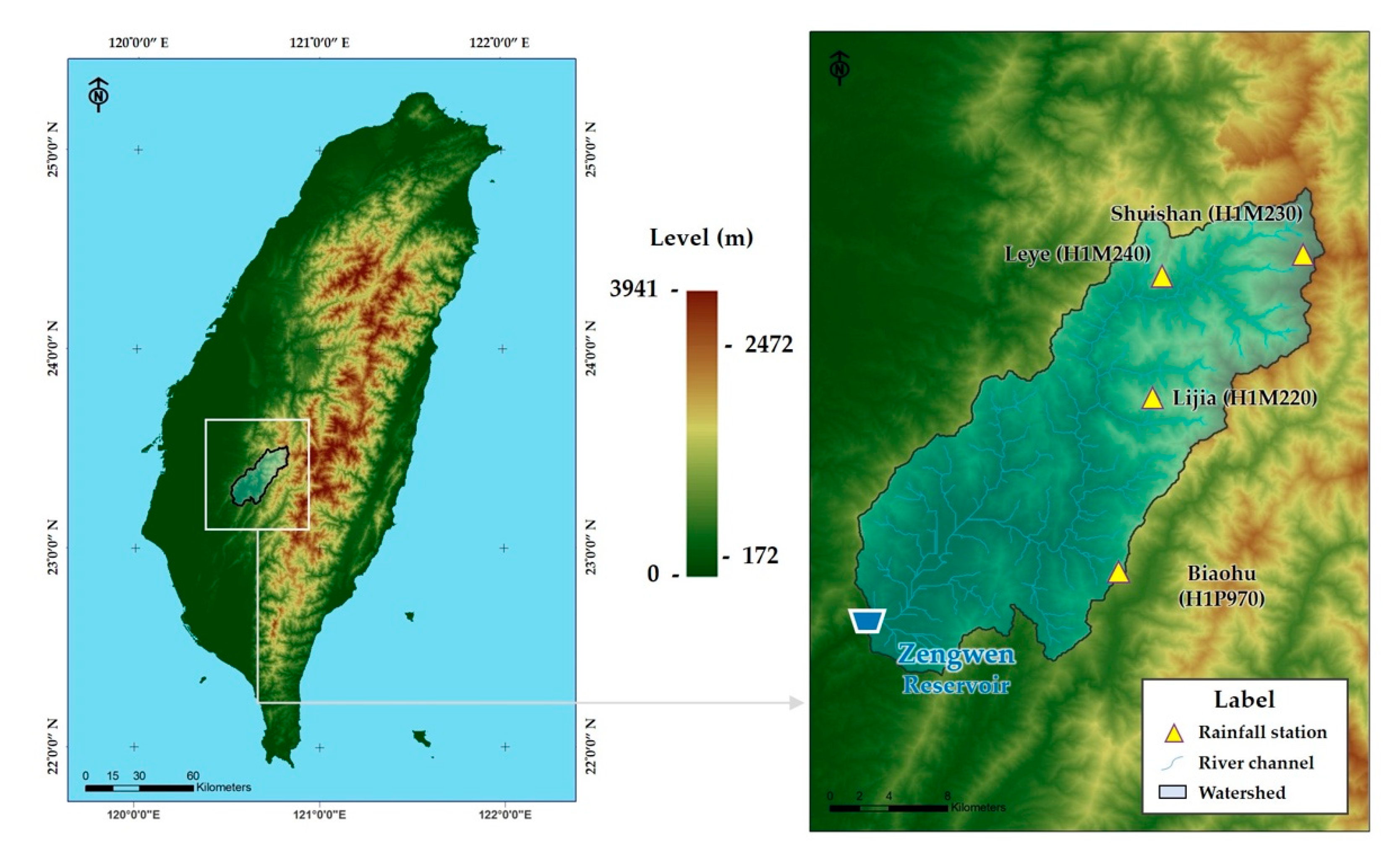
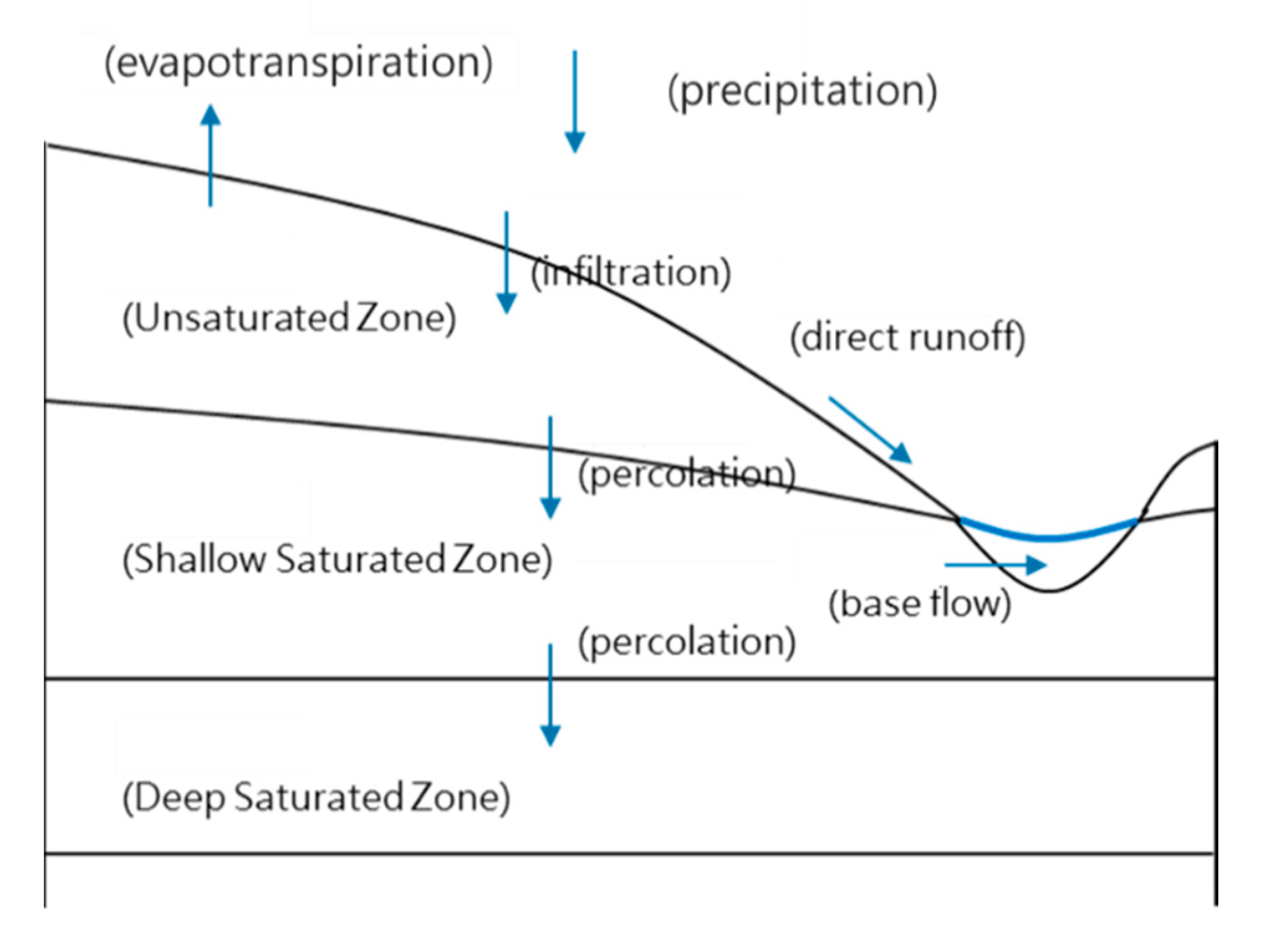
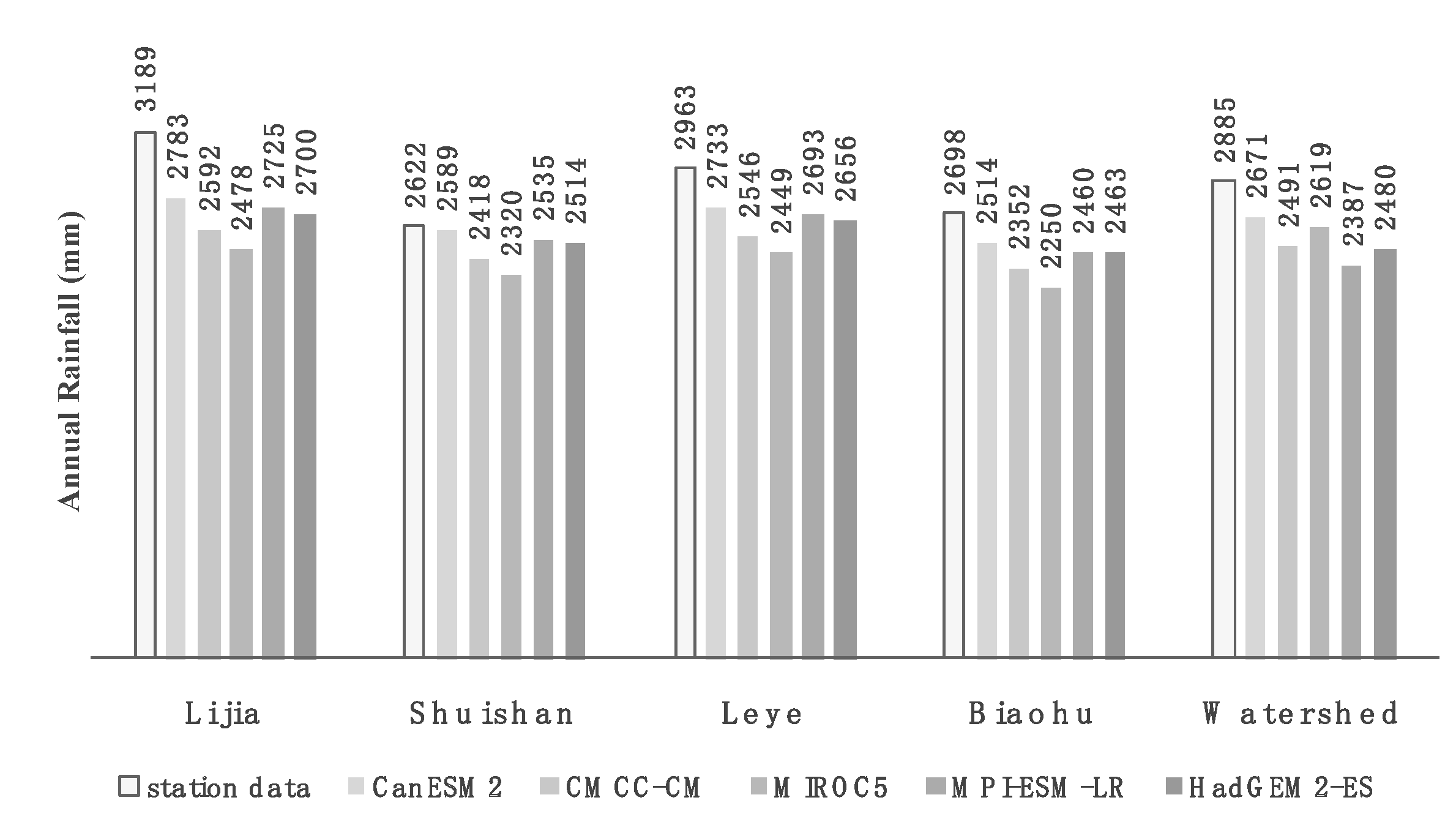
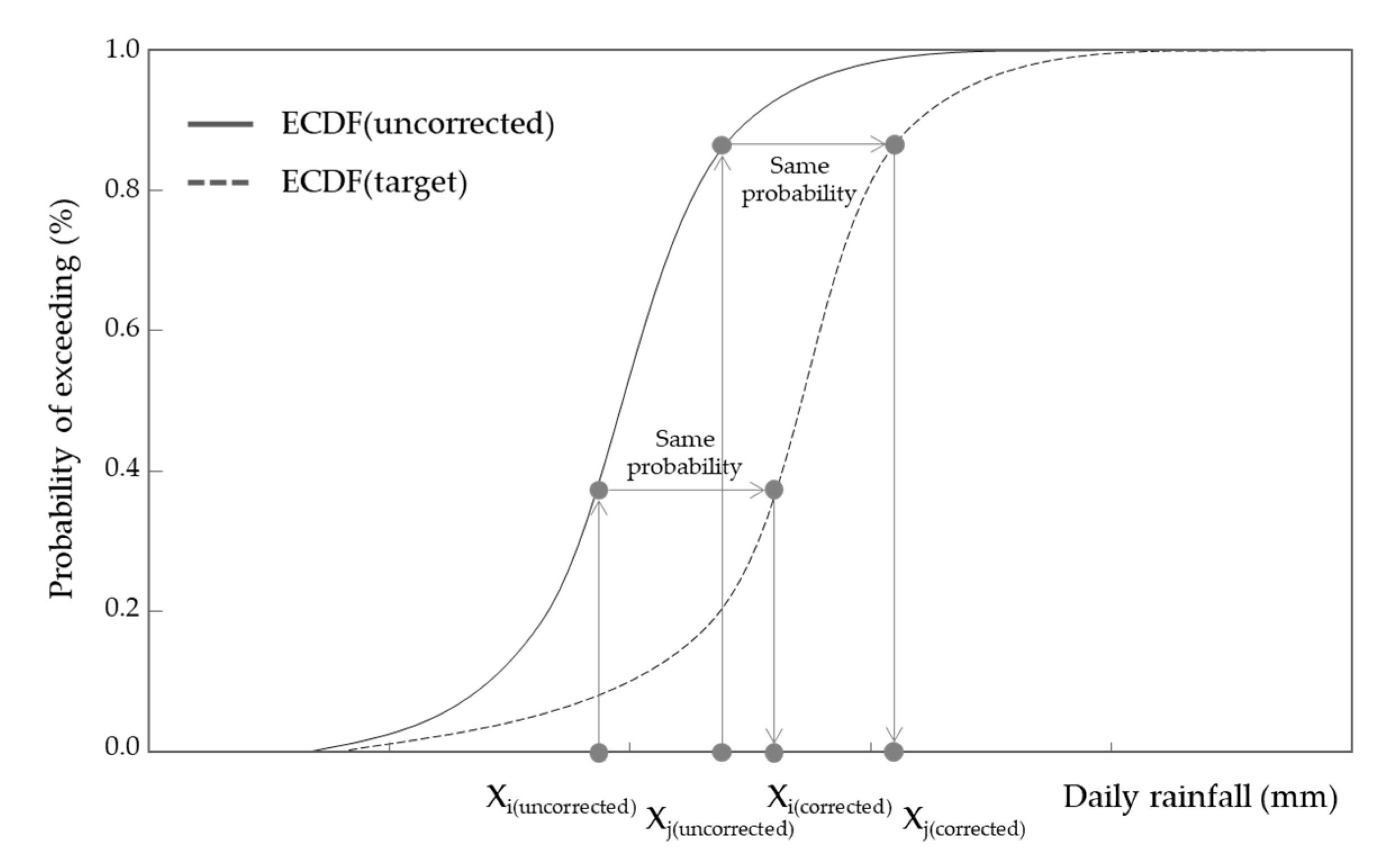
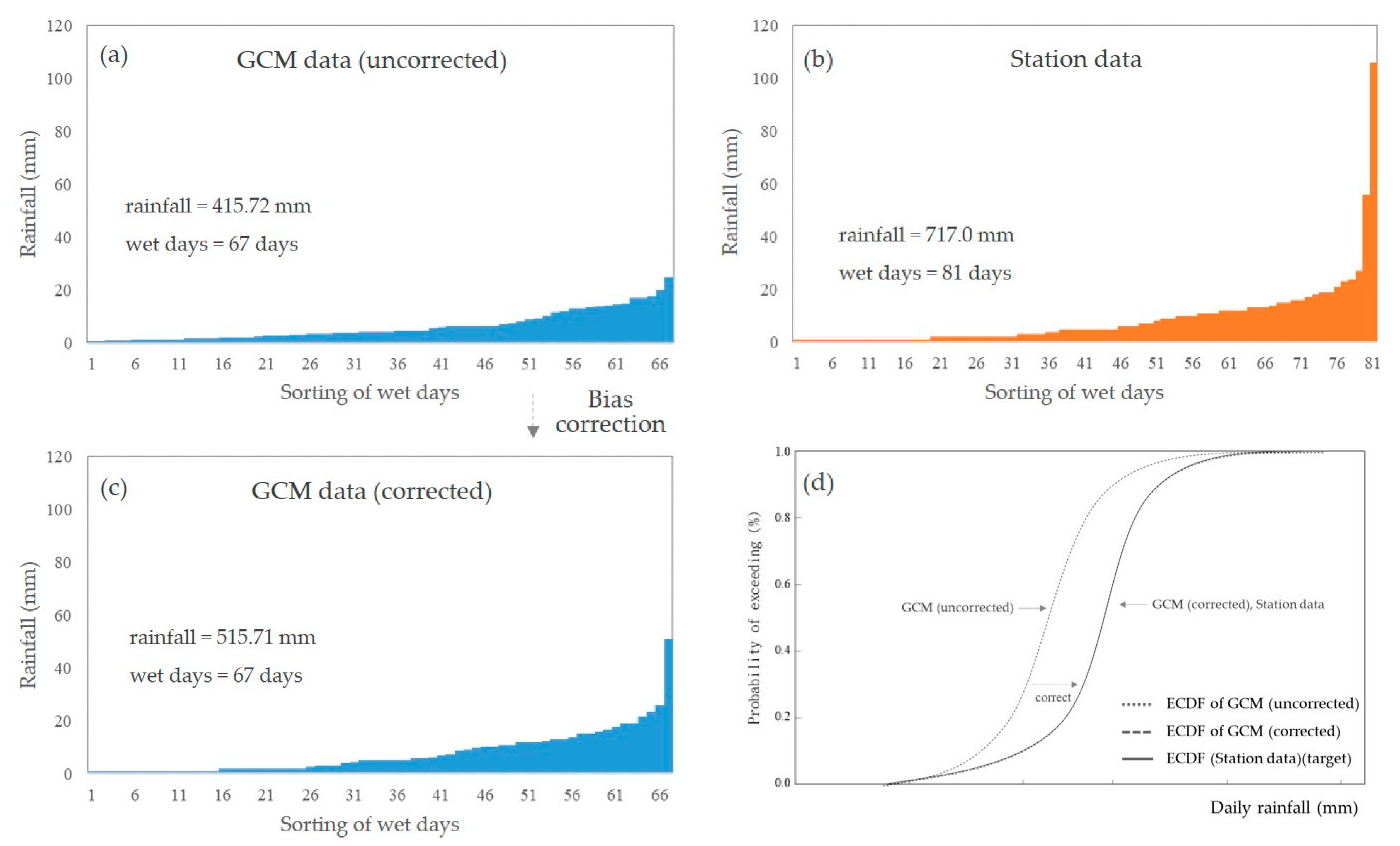
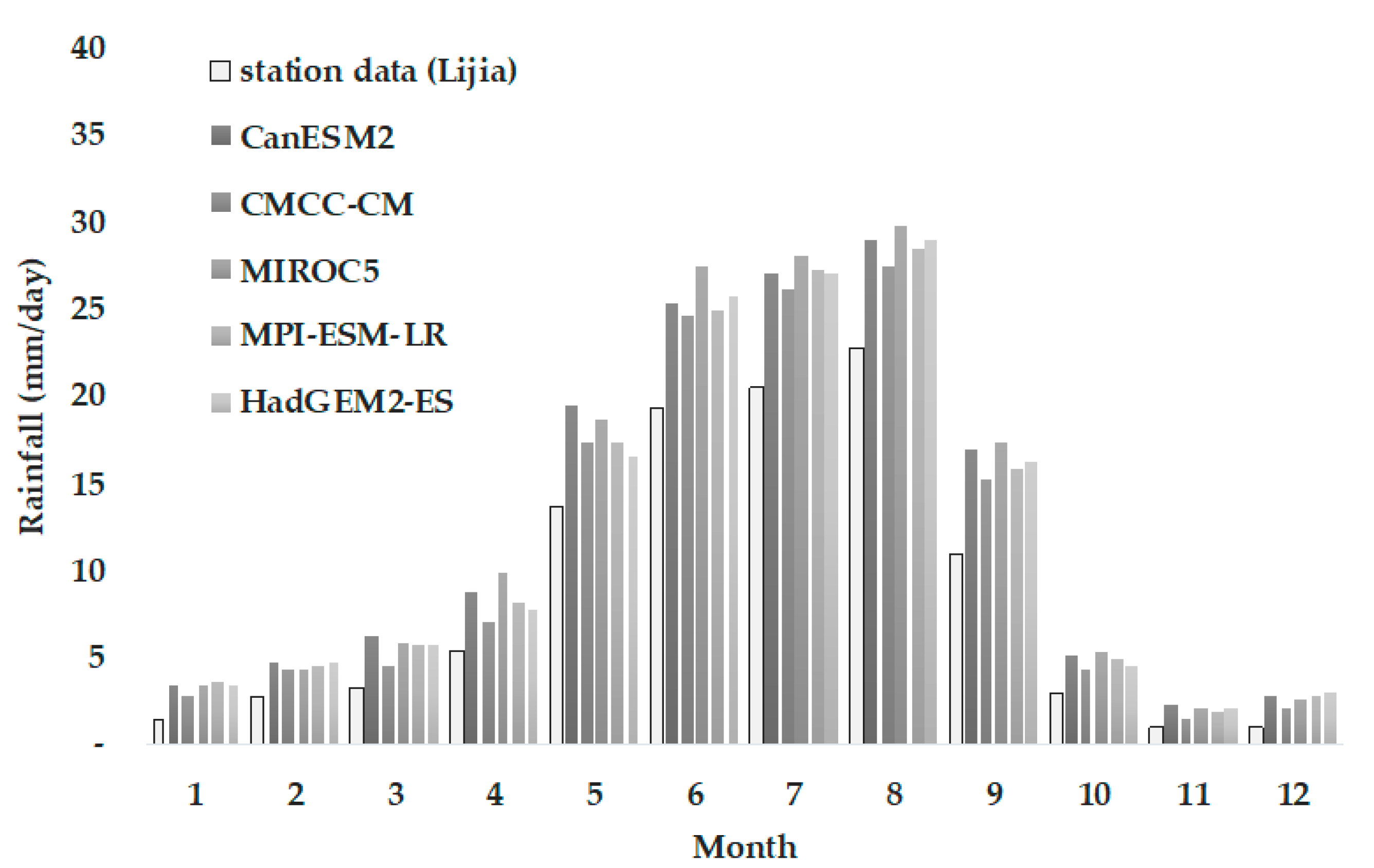
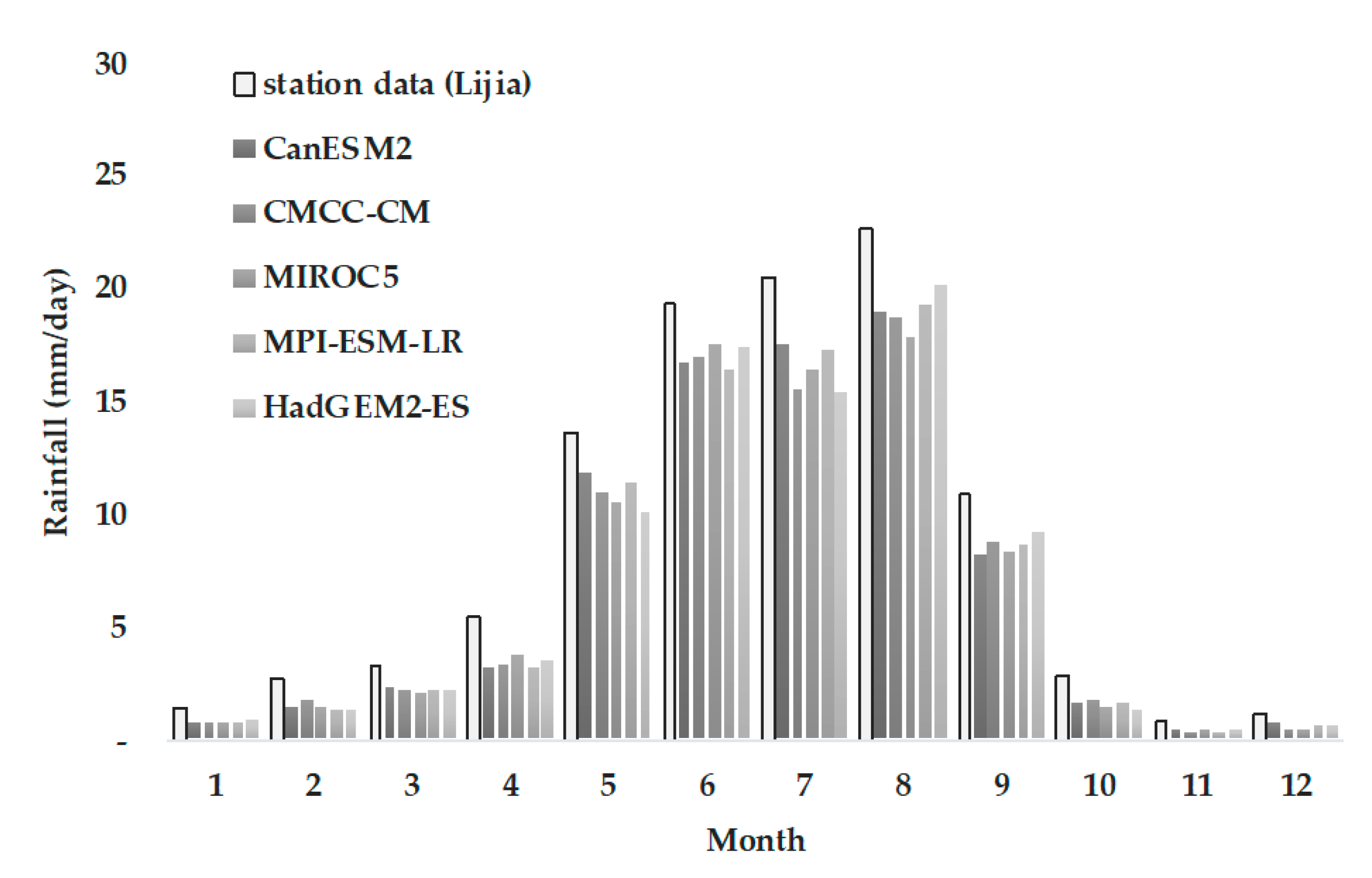
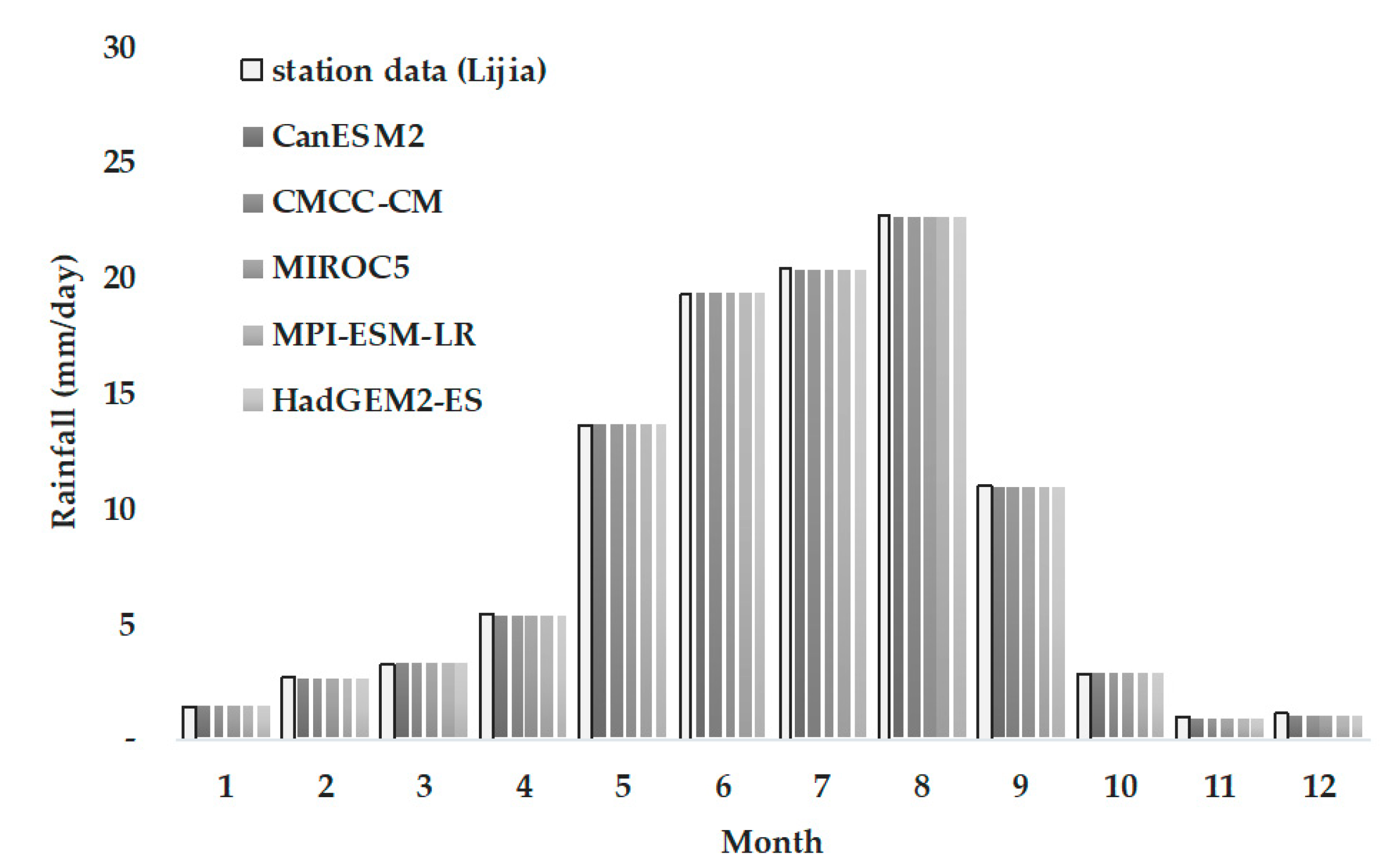

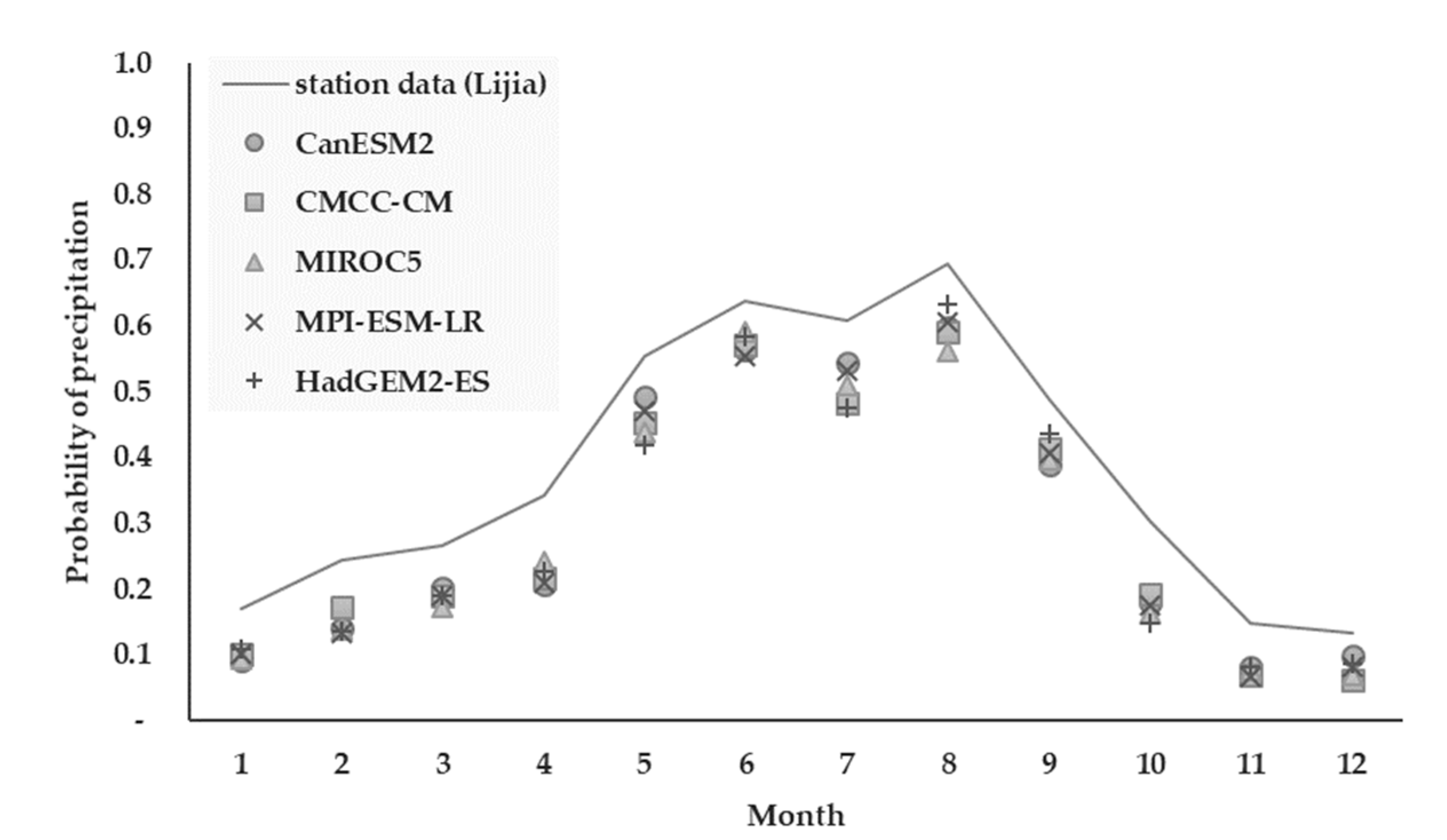
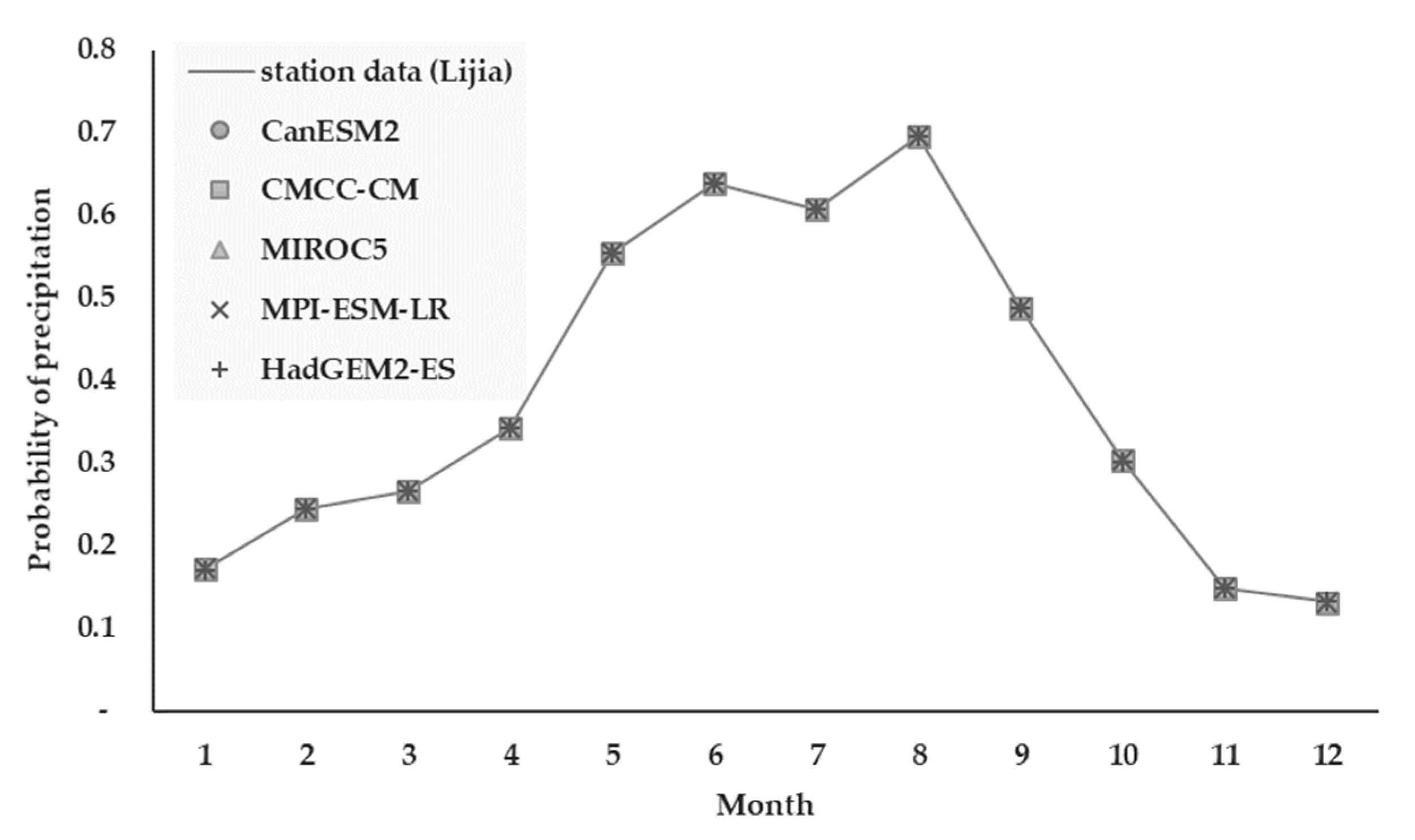
| Model Name | GCM Center | Description | Ranking |
|---|---|---|---|
| ACCESS1-0 | CSIRO-BOM | Australian Community Climate and Earth System Simulator 1.0 | 13 |
| ACCESS1-3 | Australian Community Climate and Earth System Simulator 1.3 | 30 | |
| bcc-csm1-1 | BCC | Beijing Climate Center Climate System Model version 1.1, China | 22 |
| bcc-csm1-1m | Beijing Climate Center Climate System Model version 1.1, China, high resolution | 9 | |
| BNU-ESM | BNU | College of Global Change and Earth System Science, China, Beijing Normal University Earth System Model | 8 |
| CanESM2 | CCCMA | Canadian Earth System Model version 2 | 1 |
| CCSM4 | NCAR | NCAR Community Climate System Model version 4.0 | 18 |
| CESM1-BGC | NCAR | NCAR Community Earth System Model version 1 with carbon cycle | 27 |
| CESM1-CAM5 | Coupled simulations from CESM1 using the atmosphere model of Community Atmosphere Model version 5 | 19 | |
| CMCC-CESM | CMCC | Centro Euro-Mediterraneo per I Cambiamenti Climatici (CMCC) Carbon Earth System Model | 26 |
| CMCC-CM | Centro Euro-Mediterraneo per I Cambiamenti Climatici Climate Model | 3 | |
| CNRM-CM5 | CNRM-CERFACS | Centre National de Recherches Meteorologiques (CNRM) Earth System Model version 5, France | 15 |
| CSIRO-Mk3-6-0 | CSIRO-QCCCE | CSIRO Atmospheric Research, Australia, Mk3.6 Model | 23 |
| EC-EARTH | ICHEC | Canadian Earth System Model version 2 | 29 |
| FGOALS-g2 | LASG-CESS | European Earth System Model | 33 |
| GFDL-CM3 | NOAA-GFDL | Geophysical Fluid Dynamics Laboratory Coupled Model, version 3 | 24 |
| GFDL-ESM2G | Geophysical Fluid Dynamics Laboratory Earth System Model couple TOPAZ ocean model | 11 | |
| GFDL-ESM2M | Geophysical Fluid Dynamics Laboratory Earth System Model couple MOM4 ocean model | 20 | |
| HadGEM2-AO | NIMR-KMA | Hadley Global Environment Model 2, National Institute of Meteorological Research, Seoul, South Korea | 10 |
| HadGEM2-ES | MOHC | Met Office Hadley Centre, Hadley Global Environment Model 2—Earth System | 6 |
| HadGEM2-CC | Met Office Hadley Centre, Hadley Global Environment Model 2—Carbon Cycle | 12 | |
| inmcm4 | INM | Institute for Numerical Mathematics, Russia, INMCM4.0 Model | 28 |
| IPSL-CM5A-LR | IPSL | Institute Pierre-Simon Laplace, France, with LMDZ4 atmosphere model | 16 |
| IPSL-CM5A-MR | IPSL-CM4A with medium resolution | 17 | |
| IPSL-CM5B-LR | Institute Pierre-Simon Laplace, France, with LMDZ5 atmosphere model | 14 | |
| MIROC5 | MIROC | CCSR/NIES/FRCGC, Japan, MIROC Model V5 | 4 |
| MIROC-ESM | CCSR/NIES/FRCGC, MIROC, Japan, Earth System Model | 31 | |
| MIROC-ESM-CHEM | CCSR/NIES/FRCGC, MIROC, Japan Earth System Model with Chemistry | 32 | |
| MPI-ESM-LR | MPI-M | Max Planck Institute for Meteorology, Germany, Earth System Model- low resolution grid | 2 |
| MPI-ESM-MR | Max Planck Institute for Meteorology, Germany, Earth System Model-medium resolution grid | 5 | |
| MRI-CGCM3 | MRI | Meteorological Research Institute, Japan, CGCM3 | 25 |
| MRI-ESM1 | Meteorological Research Institute, Japan, Earth System Model version 1 | 21 | |
| NorESM1-M | NCC | Norwegian Earth System Model 1—medium resolution | 7 |
| Station | ID | x Coordinate | y Coordinate | Weight of Thiessen’s Polygon | Averaged Daily Rainfall (mm) | Averaged Annual Rainfall (mm) |
|---|---|---|---|---|---|---|
| Lijia | H1M220 | 221,379 | 2,587,086 | 0.33 | 8.74 | 3189 |
| Shuishan | H1M230 | 231,675 | 2,596,636 | 0.2 | 7.18 | 2622 |
| Leye | H1M240 | 221,871 | 2,595,420 | 0.24 | 8.12 | 2963 |
| Biaohu | H1P970 | 219,259 | 2,574,930 | 0.23 | 7.39 | 2698 |
| River | Control Point | Watershed Area (KM2) | CN Value | Coefficient of Recession |
|---|---|---|---|---|
| Zengwen River | Zengwen Reservoir | 481 | 74 | 0.042 |
| Model Name | Lijia | Shuishan | Leye | Biaohu | Watershed Average |
|---|---|---|---|---|---|
| CanESM2 | −13% | −1% | −8% | −7% | −8% |
| CMCC-CM | −19% | −8% | −14% | −13% | −14% |
| MIROC5 | −22% | −12% | −17% | −17% | −10% |
| MPI-ESM-LR | −15% | −3% | −9% | −9% | −18% |
| HadGEM2-ES | −15% | −4% | −10% | −9% | −14% |
| Average | −17% | −6% | −12% | −11% | −12% |
| Model Name | Sources of Rainfall | ||||
|---|---|---|---|---|---|
| Station Data | Uncorrected | No-Threshold | Fixed-Threshold | Optimized-Threshold | |
| CanESM2 | 2093 | 1860 | 3548 | 1609 | 2156 |
| CMCC-CM | 1717 | 3155 | 1622 | 2171 | |
| HadGEM2-ES | 1800 | 3336 | 1620 | 2127 | |
| MIROC5 | 1655 | 3651 | 1651 | 2202 | |
| MPI-ESM-LR | 1836 | 3388 | 1673 | 2176 | |
| Model Name | Sources of Rainfall | ||||
|---|---|---|---|---|---|
| Station Data | Uncorrected | No-Threshold | Fixed-Threshold | Optimized-Threshold | |
| CanESM2 | 1007 | 894 | 1707 | 774 | 1037 |
| CMCC-CM | 826 | 1518 | 780 | 1044 | |
| HadGEM2-ES | 866 | 1605 | 779 | 1023 | |
| MIROC5 | 796 | 1756 | 794 | 1059 | |
| MPI-ESM-LR | 883 | 1630 | 805 | 1047 | |
| Model Name | Sources of Rainfall | |||
|---|---|---|---|---|
| Uncorrected | No-Threshold | Fixed-Threshold | Optimized-Threshold | |
| CanESM2 | −112 | 700 | −233 | 30 |
| CMCC-CM | −181 | 511 | −226 | 37 |
| HadGEM2-ES | −141 | 598 | −228 | 16 |
| MIROC5 | −211 | 749 | −213 | 52 |
| MPI-ESM-LR | −124 | 623 | −202 | 40 |
Publisher’s Note: MDPI stays neutral with regard to jurisdictional claims in published maps and institutional affiliations. |
© 2021 by the authors. Licensee MDPI, Basel, Switzerland. This article is an open access article distributed under the terms and conditions of the Creative Commons Attribution (CC BY) license (https://creativecommons.org/licenses/by/4.0/).
Share and Cite
Teng, T.-Y.; Liu, T.-M.; Tung, Y.-S.; Cheng, K.-S. Converting Climate Change Gridded Daily Rainfall to Station Daily Rainfall—A Case Study at Zengwen Reservoir. Water 2021, 13, 1516. https://doi.org/10.3390/w13111516
Teng T-Y, Liu T-M, Tung Y-S, Cheng K-S. Converting Climate Change Gridded Daily Rainfall to Station Daily Rainfall—A Case Study at Zengwen Reservoir. Water. 2021; 13(11):1516. https://doi.org/10.3390/w13111516
Chicago/Turabian StyleTeng, Tse-Yu, Tzu-Ming Liu, Yu-Shiang Tung, and Ke-Sheng Cheng. 2021. "Converting Climate Change Gridded Daily Rainfall to Station Daily Rainfall—A Case Study at Zengwen Reservoir" Water 13, no. 11: 1516. https://doi.org/10.3390/w13111516
APA StyleTeng, T.-Y., Liu, T.-M., Tung, Y.-S., & Cheng, K.-S. (2021). Converting Climate Change Gridded Daily Rainfall to Station Daily Rainfall—A Case Study at Zengwen Reservoir. Water, 13(11), 1516. https://doi.org/10.3390/w13111516






